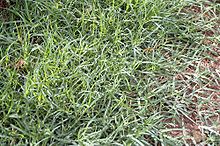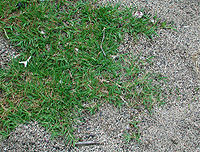Cynodon dactylon
| Cynodon dactylon | |
|---|---|

| |
| Scientific classification | |
| Kingdom: | |
| (unranked): | |
| (unranked): | |
| Order: | |
| Family: | |
| Genus: | |
| Species: | C. dactylon
|
| Binomial name | |
| Cynodon dactylon | |
| Synonyms[1] | |
|
List
| |
Cynodon dactylon, also known as Vilfa stellata[2] dūrvā grass, Dhoob, Bermuda grass, dubo, dog's tooth grass,[3] Bahama grass, devil's grass, couch grass, Indian doab, arugampul, grama, wiregrass and scutch grass, is a grass that originated in the Middle East.[4] Although it is not native to Bermuda, it is an abundant invasive species there. It is presumed to have arrived in North America from Bermuda, resulting in its common name.[citation needed] In Bermuda it has been known as crab grass.
Description
The blades are a grey-green color and are short, usually 2–15 cm (0.79–5.91 in) long with rough edges.[5] The erect stems can grow 1–30 cm (0.39–11.81 in) tall. The stems are slightly flattened, often tinged purple in colour.
The seed heads are produced in a cluster of two to six spikes together at the top of the stem, each spike 2–5 cm (0.79–1.97 in) long.[5]
It has a deep root system; in drought situations with penetrable soil, the root system can grow to over 2 metres (6.6 ft) deep, though most of the root mass is less than 60 centimetres (24 in) under the surface. The grass creeps along the ground and roots wherever a node touches the ground, forming a dense mat. C. dactylon reproduces through seeds, runners, and rhizomes. Growth begins at temperatures above 15 °C (59 °F) with optimum growth between 24 and 37 °C (75 and 99 °F); in winter, the grass becomes dormant and turns brown. Growth is promoted by full sun and retarded by full shade, e.g., close to tree trunks.
Cultivation, control and uses
Cynodon dactylon is widely cultivated in warm climates all over the world between about 30° S and 30° N latitude, and that get between 625 and 1,750 mm (24.6 and 68.9 in) of rainfall a year (or less, if irrigation is available). It is also found in the U.S., mostly in the southern half of the country and in warm climates.
Control/Eradication
It is fast-growing and tough, making it popular and useful for sports fields, as when damaged it will recover quickly. It is a highly desirable turf grass in warm temperate climates, particularly for those regions where its heat and drought tolerance enable it to survive where few other grasses do. This combination makes it a frequent choice for golf courses in the southern and southeastern U.S. It has a relatively coarse-bladed form with numerous cultivars selected for different turf requirements. It is also highly aggressive, crowding out most other grasses and invading other habitats, and has become a hard-to-eradicate weed in some areas (it can be controlled somewhat with Triclopyr, Mesotrione, Fluazifop-p-butyl, and Glyphosate).[6][7] This weedy nature leads some gardeners to give it the name of "devil grass". Bermuda grass is incredibly difficult to control in flower beds and most herbicides do not work. However, Ornamec, Ornamec 170 and Turflon ester (tricyclopyr) have shown some effectiveness as well as Imazapyr. All of these items are difficult to find in retail stores as they are primarily marketed to professional landscapers. [8]
Bermuda grass has been cultivated on saline soils in California's Central Valley which are too salt-damaged to support agricultural crops; it was successfully irrigated with saline water and used to graze cattle.[9][10]
The hybrid variety Tifton 85, like some other grasses (e.g. sorghum), produces cyanide under certain conditions,[11] and has been implicated in several livestock deaths (note that in several places this variety has been incorrectly reported as a genetically modified strain;[12] actually it is a conventionally bred F1 hybrid[13]).
-
C. dactylon growing in Kaloko-Honokohau National Historical Park on the Island of Hawaiʻi
Varieties
- Tifgreen (drought resistant)[14]
- Tifway 419 (Athletic Fields, Fairways, Golf Course Tees)[15]
- LaPaloma
- Riviera
- SR9554
- Laprima
- Veracruz
- Wrangler
- Yukon
- AgriDark (Sports Turf - Australia & New Zealand) [16]
- OZTUFF (Low Maintenance Couch - Australia, PBR under OZ-E-GREEN) [17] [18]
See also
References
- ^ "The Plant List: A Working List of All Plant Species".
- ^ Tropicos.org. Missouri Botanical Garden http://www.tropicos.org/Name/100389014?tab=acceptednames. Retrieved 5 December 2015.
{{cite web}}: Missing or empty|title=(help) - ^ "Iraq". lntreasures.com. Retrieved 5 November 2015.
- ^ Farsani TM, Etemadi N, Sayed-tabatabaei BE, Talebi M. Assessment of Genetic Diversity of Bermudagrass (Cynodon dactylon) Using ISSR Markers. Int J Mol Sci. 2012;13(1):383-92.
- ^ a b Walker, Karen; Burrows, Geoff; McMahon, Lynne (2001). Bidgee bush : an identification guide to common native plant species of the south western slopes of New South Wales. Yarralumla, Australian Capital Territory: Greening Australia. p. 82. ISBN 1-875345-61-2. Retrieved 21 March 2010.
- ^ "Tenacity and Bermuda Control - LawnSite.com™ - Lawn Care & Landscaping Business Forum". Lawnsite.com. 2011. Retrieved 2013-06-08.
- ^ Teuton T.C.; J.B. Unruh; B.J. Brecke; G.L. Miller (2005). "Hybrid Bermudagrass (Cynodon dactylon (L) Pers. x C. transvaalensis Burtt-Davy) Control with Glyphosate and Fluazifop-p-butyl". Applied Turfgrass Science. doi:10.1094/ATS-2005-0119-01-RS.
- ^ http://turf.uark.edu/research/research%20series/475/BERMUDAGRASS%20CONTROL%20WITH%20ARSENAL.pdf
- ^ Kaffka, Stephen. "Can feedstock production for biofuels be sustainable in California?" (PDF). California Agriculture. 63 (4): 202–207. doi:10.3733/ca.v063n04p202.
- ^ Stephen Kaffka; Stephen Grattan; Dennis Corwi; Maximo Alonso; George E. Brown Jr. "Bermuda Grass Yield and Quality in Response to Different Salinity and N, Se, Mo, and B Rates in West San Joaquin Valley" (PDF). UC Center for Water Resources.
- ^ Provin, T. L.; Pitt, J. L. "Nitrates and Prussic Acid in Forages" (PDF). Texas A&M University System. Retrieved June 24, 2012.
- ^ CBS News (June 23, 2012). "GM grass linked to Texas cattle deaths". CBS News. Retrieved June 24, 2012.
- ^ Glenn W. Burton; Roger N. Gates; Gary M. Hill. "TIFTON 85 BERMUDAGRASS". University of Georgia College of Agricultural and Environmental Sciences. Retrieved June 24, 2012.
- ^ Shi H, Wang Y, Cheng Z, Ye T, Chan Z. Analysis of natural variation in bermuda grass (Cynodon dactylon) reveals physiological responses underlying drought tolerance. PLoS ONE. 2012;7(12):e53422.
- ^ "Tifway 419 Bermudagrass Turf Grass - Phillip Jennings Turf Farms". www.sodfather.com. Retrieved 2016-05-10.
- ^ http://www.allturfsolutions.com.au/turf-varieties/agridark/
- ^ http://www.allturfsolutions.com.au/turf-varieties/oz-tuff/
- ^ http://pericles.ipaustralia.gov.au/pbr_db/plant_detail.cfm?AID=18778309



